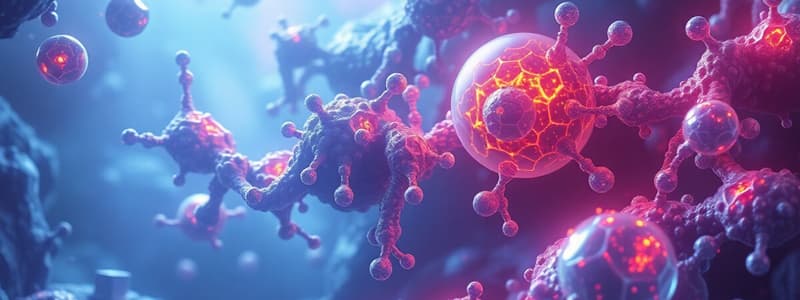Podcast
Questions and Answers
What is the role of enzymes in relation to the transition state of a chemical reaction?
What is the role of enzymes in relation to the transition state of a chemical reaction?
- Enzymes increase the energy barrier between reactants and products.
- Enzymes provide an alternative pathway with a lower activation energy. (correct)
- Enzymes convert reactants directly into products without affecting the transition state.
- Enzymes have no effect on the transition state of reactions.
How does the number of substrate molecules in the transition state affect the rate of a reaction?
How does the number of substrate molecules in the transition state affect the rate of a reaction?
- The rate remains constant regardless of substrate concentration.
- The rate decreases as the number of substrate molecules increases.
- The rate is only affected by the activation energy, not the substrate concentration.
- The rate of the reaction varies directly with the number of substrate molecules in the transition state. (correct)
What is the effect of enzymes on the energy of activation (Ea) for a reaction?
What is the effect of enzymes on the energy of activation (Ea) for a reaction?
- Enzymes only lower the energy of activation for forward reactions and not for reverse ones.
- Enzymes have no effect on the energy of activation.
- Enzymes increase the energy of activation for both forward and reverse reactions.
- Enzymes lower the energy of activation, facilitating faster reactions. (correct)
In classification of enzymes, which aspect relates them to their function in biological processes?
In classification of enzymes, which aspect relates them to their function in biological processes?
What is the clinical relevance of understanding the mechanism of enzyme action?
What is the clinical relevance of understanding the mechanism of enzyme action?
Which type of enzyme is responsible for catalyzing the oxidation-reduction reactions by removing hydrogen or electrons from substrates?
Which type of enzyme is responsible for catalyzing the oxidation-reduction reactions by removing hydrogen or electrons from substrates?
What is the primary function of ligases in biochemical reactions?
What is the primary function of ligases in biochemical reactions?
Which enzyme category catalyzes the cleavage of C-C, C-S, or C-N bonds?
Which enzyme category catalyzes the cleavage of C-C, C-S, or C-N bonds?
Which enzyme type is known for catalyzing reactions that result in the rearrangement of isomers?
Which enzyme type is known for catalyzing reactions that result in the rearrangement of isomers?
What role do tissue plasminogen activators serve in clinical settings?
What role do tissue plasminogen activators serve in clinical settings?
Study Notes
Enzyme Action Mechanism
- Enzymes are biological catalysts that accelerate chemical reactions by providing an alternative pathway with a lower activation energy.
- The transition state is the high-energy state of a molecule where bonds are most likely to break or form.
- Enzymes lower the activation energy required for the reaction to proceed by facilitating the formation of the transition state.
- The rate of a reaction is directly proportional to the number of substrate molecules in the transition state.
Enzyme Classification
- Enzymes are classified into six main categories based on their function:
Oxidoreductases
- Catalyze oxidation-reduction reactions.
- Involve the transfer of electrons or hydrogen atoms.
- Examples: Lactate dehydrogenase, which is a key enzyme in glycolysis.
Transferases
- Catalyze the transfer of functional groups, such as C, N, or P, from one molecule to another.
- Examples: Serine hydroxymethyltransferase, which transfers a hydroxymethyl group from tetrahydrofolate to serine.
Hydrolases
- Catalyze the cleavage of bonds by adding water molecules, also known as hydrolysis.
- Examples: Urease, which breaks down urea into ammonia and carbon dioxide.
Lyases
- Catalyze the cleavage of C-C, C-S, or C-N bonds by a mechanism other than hydrolysis.
- Examples: Pyruvate decarboxylase, which removes CO₂ from pyruvate.
Isomerases
- Catalyze the rearrangement of atoms within a molecule.
- Convert one isomer to another.
- Examples: Methylmalonyl CoA mutase, which rearranges methylmalonyl CoA into succinyl CoA in the citric acid cycle.
Ligases
- Catalyze the joining of two molecules coupled with the hydrolysis of ATP (a high-energy molecule).
- Examples: Pyruvate carboxylase, which joins pyruvate with carbon dioxide to form oxaloacetate.
Clinical Implications of Enzyme Action
- Enzyme activation: Some drugs activate specific enzymes to produce desired effects.
- Tissue plasminogen activators, like alteplase, are used to activate plasmin, an enzyme that breaks down fibrin clots.
- Alteplase is used for emergency lysis of blood clots in cases of acute myocardial infarction.
- Enzyme inhibition: Some drugs block the action of certain enzymes to achieve therapeutic outcomes.
- Non-steroidal anti-inflammatory drugs (NSAIDs) like ibuprofen inhibit cyclooxygenase (COX) activity.
- COX is responsible for producing mediators of inflammation (prostaglandins).
- NSAIDs are used to manage pain, fever, and inflammation.
- Anticholinesterases like pyridostigmine inhibit cholinesterase, the enzyme responsible for degrading acetylcholine.
- Acetylcholine is a neurotransmitter that plays a vital role in muscle contraction.
- Anticholinesterases are used in the treatment of Myasthenia Gravis, an autoimmune disease affecting neuromuscular junction function.
- Non-steroidal anti-inflammatory drugs (NSAIDs) like ibuprofen inhibit cyclooxygenase (COX) activity.
Studying That Suits You
Use AI to generate personalized quizzes and flashcards to suit your learning preferences.
Related Documents
Description
This quiz covers the essential concepts of enzyme action mechanisms, including how enzymes function as biological catalysts and facilitate reactions. You'll also learn about the classification of enzymes into various categories based on their functions, such as oxidoreductases and transferases.




